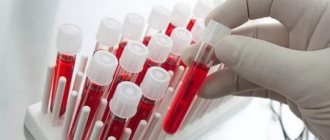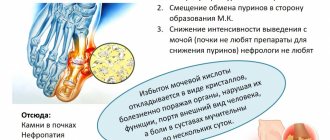When should you take a general T4 test?
- Suspicion of hypo- or hyperthyroidism;
- Changes in the size of the thyroid gland;
- Uncontrolled weight loss;
- Prolonged depression or irritability;
- Increase or decrease in the concentration of thyroid-stimulating hormone;
- Routine examination during pregnancy;
- Examination in the absence of menstruation or suspected infertility;
- Deviations in the development of children;
- Control in the treatment of gland diseases;
- Examination of persons with a predisposition to thyroid diseases.
Interpretation of results in children and adults
The main reasons for the increase in the concentration of free thyroxine
- Hyperfunction of the thyroid gland with:
- diffuse toxic goiter. The development of the disease is preceded by disturbances in the activity of the thyroid gland of genetic, autoimmune or inflammatory origin. Unfavorable factors (stress, respiratory infections) can activate the thyroid gland and provoke the development of the disease;
- thyroiditis – inflammation of the thyroid gland of an infectious or autoimmune nature;
- postpartum thyroiditis. The pathology is considered a variant of autoimmune thyroiditis. The classic manifestation is temporary thyrotoxicosis, which occurs in three phases (thyrotoxicosis, hypothyroidism, recovery).
- Taking synthetic thyroid hormones.
- Excessive intake of iodine into the body (including with radiocontrast agents).
- Pathologies affecting the level and ability of specific proteins to bind hormones (hepatitis and cirrhosis lead to a decrease in the level of thyroxine-binding globulin).
- Tumors of the pituitary gland, accompanied by an increase in the level of thyroid-stimulating hormone.
The main reasons for the decrease in the concentration of free thyroxine
- Weakening of thyroid function in primary hypothyroidism, after removal of a lobe of the thyroid gland, and in case of thyroid cancer.
- Taking thyreostatic drugs.
- Iodine deficiency.
- Secondary hypothyroidism, in which the pituitary gland produces little thyroid-stimulating hormone. Causes: inflammation or neoplasm in the pituitary gland.
- Tertiary hypothyroidism, caused by a decrease in the production of thyrotropin-releasing hormone by the hypothalamus due to traumatic brain injury, inflammatory, autoimmune, and vascular disorders.
If the indicator deviates from the norm, the following studies are additionally carried out: total triiodothyronine (T3 total, Total Triiodthyronine, TT3), free triiodothyronine (T3 free, Free Triiodthyronine, FT3), total thyroxine (T4 total, total tetraiodothyronine, Total Thyroxine, TT4), thyroid stimulating hormone (TSH, thyrotropin, Thyroid Stimulating Hormone, TSH).
Detailed description of the study
The thyroid gland is an organ of the endocrine system. The main structural component is the thyroid follicles, which contain the protein thyroglobulin (TG). It serves as a substrate for the synthesis of hormones such as thyroxine (T4) and triiodothyronine (T3).
Thyroxine is one of two thyroid hormones that are produced in the thyroid gland. Its other name is T4, or L-thyroxine. This name is given due to the addition of 4 iodine atoms to the amino acid L-tyrosine.
Thyroxine circulates in the human body in combination with plasma proteins (about 99%), and only a small part is in a free state. Total thyroxine is an indicator that reflects the concentration of both free and bound thyroxine.
The main functions of thyroxine in the body:
- Activation of metabolic processes;
- Acceleration of oxidative reactions in cells;
- Stimulation of cell growth and division;
- Reducing the concentration of cholesterol in the blood;
- Effect on the central nervous system;
- Increased heart rate;
- May affect vitamin A metabolism.
During the day or depending on the time of year, the concentration of T4 may vary slightly within the reference values. During pregnancy, the norms of total thyroxine are slightly different. This is due to the fact that estrogens and placental hormones have a stimulating effect on the thyroid gland.
The concentration of thyroxine in the blood is an important indicator of thyroid function. In clinical practice, it is important to differentiate diseases such as hyperthyroidism (excessive production of thyroid hormones), hypothyroidism (lack of thyroid hormones) from euthyroidism, a condition in which normal hormone levels are determined.
Excess total thyroxine affects all processes in the body. The effect on lipid metabolism leads to increased breakdown of fat molecules and, as a result, a person notices weight loss. Long-term elevated concentrations of thyroxine reduce the calcium content of bone tissue, which increases the risk of fractures.
One of the most common causes of hyperthyroidism is autoimmune thyroiditis (at the onset of the disease). This is an immune-mediated disorder of the thyroid gland. Symptoms that are characteristic of elevated thyroxine levels (hyperthyroidism):
- Increased activity;
- Increased sweating;
- Insomnia;
- Cardiopalmus;
- Trembling of limbs;
- Loss of body weight.
Prolonged inflammation in autoimmune thyroiditis leads to destruction of thyroid tissue, which over time is expressed as a decrease in hormone production - hypothyroidism.
Symptoms that are characteristic of reduced thyroxine levels (hypothyroidism):
- Weakness, increased fatigue;
- Tendency to swelling;
- Decreased heart rate;
- Dry skin;
- Muscle and joint pain;
- Slowing of growth and development (in children);
- Weight gain;
- Hair loss.
Changes in the concentration of thyroid hormones can also lead to an imbalance of sex hormones. This is manifested by menstrual irregularities and infertility.
There are medications that can affect the thyroid gland. For example, amiodarone (an antiarrhythmic drug) can cause both a decrease and an excess release of its hormones.
Determination of total thyroxine is necessary for everyone who suspects thyroid disease. In addition, the analysis is important for people receiving treatment with drugs that affect the release of thyroid hormones. Early diagnosis of thyroid pathology will allow timely treatment and avoid complications in the future.
Preparation for the procedure
- Blood should be donated for testing at the same time (if it is necessary to track the dynamics of the indicator or the effectiveness of treatment), preferably between 8:00 and 12:00.
- Discuss with your doctor the use of medications that affect the level of thyroid hormones (hormone replacement therapy, thyreostatic drugs). To assess the function of the thyroid gland, it is necessary, in agreement with the doctor, to cancel them a month before the test.
- Two to three days before the test, avoid physical activity, sports training, and stress.
- On the eve of the analysis, it is not recommended to conduct studies using radiocontrast agents.
Properties of hormones
TSH is a glycoprotein hormone produced by the pituitary gland. TSH acts as a stimulant for the secretion of gland hormones. Its detection and analysis are carried out to identify chronic diseases that are asymptomatic, including mental illnesses.
The main function is the regulation of energy metabolism. In addition, it regulates the functioning of the genitourinary and digestive systems and the transmission of nerve impulses.
Free thyroxine or T4 is a precursor of triiodothyronine. Production occurs directly in the thyroid cells. Its main task is to regulate the rate of energy exchange, increase energy production and oxygen absorption by cells in the body.
Why is hypothyroidism dangerous?
If free T4 is below normal for a long time, a person may have the following conditions:
- cretinism - mental retardation;
- anasarca - painful swelling of the skin;
- myxedema - swelling of the subcutaneous tissue and skin;
- adenoma of the anterior pituitary gland is a benign tumor;
- anemia - decreased level of hemoglobin in the blood;
- hypothyroid coma (mortality reaches 50-80%).
Thyroxine is involved in the formation of the internal organs of the embryo. Low T4 levels during pregnancy can negatively affect fetal development and cause miscarriage. In newborns born with hypothyroidism, in 30% of cases, underdevelopment, complete or partial absence of the thyroid gland is diagnosed.
Norm of free thyroxine
Reference values for thyroxine are not gender specific, but vary depending on the age of the patient.
Invitro laboratory standards for 2021:
| Age | Free T4 level, pmol/l |
| 5 days – 15 days | 13, 47-41,32 |
| 15 days – 30 days | 8,71-32,53 |
| 30 days – 6 months. | 11,42-21,89 |
| 6 months - 13 years | 10,80 -16,40 |
| 13 years – 18 years | 10,20 – 15,50 |
| over 18 years old | 9,00 – 19,05 |
Important! Standards may vary depending on the reagents and equipment used in each particular laboratory. That is why, when interpreting the results, it is necessary to use the standards adopted in the laboratory where the analysis was carried out. You also need to pay attention to the units of measurement.
Helix laboratory data, 2021:
| Age | Reference values, pmol/l |
| < 4 months | 11,5 — 28,3 |
| 4 months - 1 year | 11,9 — 25,6 |
| 17 years | 12,3 — 22,8 |
| 7 – 12 years | 12,5 — 21,5 |
| 12 – 20 years | 12,6 — 21,0 |
| > 20 years | 10,8 — 22,0 |
| During pregnancy | |
| Gestational age | Reference values |
| Until the 13th week | 12,1 — 19,6 |
| 13-28 week | 9,6 — 17 |
| 28-42 weeks | 8,4 — 15,6 |
Important! The interpretation of the results is always carried out comprehensively. It is impossible to make an accurate diagnosis based on only one analysis.
Severity
Hyperthyroidism has three degrees of severity depending on the concentration of T4 and the relationship with TSH.
The mild course of the symptom is designated subclinical and is defined if T4 is in the normal range and TSH is slightly elevated. This form of the disease is easily tolerated, showing virtually no symptoms.
The average severity of the course is already indicated by the disease and in medicine is called manifest hyperthyroidism. It is diagnosed if T3 and T4 are higher than normal, and TSH is lower. The greater the deviation of thyroxine from the norm, the more disturbances in the body’s endocrine system.
The severe form is called thyrotoxicosis and is diagnosed when thyroxine levels are high and TSH is in the normal range or low. This form of chronic hyperthyroidism has pronounced symptoms and clinical picture. The primary cause of thyrotoxicosis is diffuse toxic goiter.
Symptoms of hypothyroidism.
Regardless of the cause of hypothyroidism, the level of T4 in the blood decreases. In this case, a decrease in general metabolism occurs, and the following negative changes are observed:
- lethargy, drowsiness, fatigue;
- decreased attention, concentration, memory;
- unmotivated mood swings;
- loss of hair, eyelashes, eyebrows;
- weight gain with unchanged diet and physical activity;
- peeling skin, dull hair, brittle nails;
- feeling of cold, cold hands and feet even in a warm room;
- swelling of the face, neck;
- constipation;
- in women - heavy, painful menstruation or amenorrhea;
- in men – decreased potency.
Hypothyroidism most often affects women over forty years of age. The incidence of primary hypothyroidism varies in different regions. In those places where there is a deficiency of iodine in water and soil, a characteristic type of hypothyroidism is common - endemic goiter, when, under conditions of iodine deficiency, the thyroid gland is not able to produce a normal amount of hormones.
With peripheral hypothyroidism associated with low sensitivity of tissues to T3 and T4, not the entire complex of symptoms may be observed, but only part of them, because The decrease in sensitivity may be uneven.
Hyperthyroidism and its symptoms
The most common cause of increased free thyroxine concentrations is hyperthyroidism. In medical practice, it is not customary to call this phenomenon a disease, therefore hyperthyroidism is considered a clinical syndrome. The most striking clinical picture that blood tests can provide is an increase in T4 against the background of normal or decreased TSH levels.
The main symptoms accompanying hyperthyroidism manifest themselves in the psycho-emotional state of the patient. Most often it is short temper, excitability, irritability, increased sensitivity, difficulty falling asleep, and tearfulness. Physically, symptoms manifest themselves in a sharp weight loss accompanied by increased appetite, diarrhea, and sweating.
Other symptoms:
- a sharp deterioration in health in hot weather,
- tremor of the limbs,
- arrhythmia and tachycardia,
- frequent urge to defecate,
- disruptions in menstruation, amenorrhea,
- exophthalmos, also known as bulging eyes, swelling of the eyelids,
- lacrimation, inability to concentrate vision,
- hair loss and fragility, flaking and softness of nails.
Decreased free T4
- hypothyroidism (mainly congenital);
- endemic goiter (pathology of the thyroid gland);
- thyroiditis;
- cancer tumors localized in the thyroid gland;
- operations in the gland area, amputation of its individual parts;
- thyrotropinoma (pituitary tumor);
- iodine deficiency in the body;
- inflammatory processes in the pituitary gland and hypothalamus, traumatic brain injury;
- Sheehan syndrome (death of pituitary tissue after childbirth, accompanied by bleeding and hypotension);
- a sharp decrease in body weight;
- use of heroin and other drugs (hormones, oral contraceptives, anticonvulsants, lithium, steroids, etc.).
- lead poisoning.
What symptoms indicate low T4 levels?
The main symptoms of low T4 are:
- constant fatigue;
- frequent mood changes;
- bradycardia (slow heart rate, sometimes with pauses);
- unexplained obesity;
- in women - menstrual irregularities;
- in men – loss of muscle mass, erectile dysfunction;
- good appetite without weight gain (in a child).
A decrease in the level of free thyroxine also negatively affects the condition of the skin, hair and nails.
T4 hormone test
In the clinical practice of endocrinologists, analysis of the hormones TSH and T4 is the most commonly used diagnostic method. Hormonal tests are prescribed in various combinations, taking into account the symptoms and economic capabilities of the patient.
At the initial visit to the endocrinologist, if the patient does not have severe symptoms, it is often enough to take a test for the hormones TSH, T4, T3. As for the last two hormones, it is better to study their active, i.e., free fractions. In cases where the patient receives thyreostatics for the treatment of the early stage of Graves' disease (diffuse toxic goiter), it is better to determine only the free hormones T3 and T4. Under the influence of thyreostatic drugs, a rapid decrease in these indicators occurs, while the TSH level seems to be delayed and does not have time to decrease.
If a patient is being treated for a long time for insufficient gland function, then for periodic monitoring of the quality of therapy it is enough to determine only the concentration of thyroid-stimulating hormone (TSH). Free T4 is tested only if there are specific indications. You should know that if you are taking thyroxine, you can take a blood test for the T4 hormone only before taking it
. If this rule is not followed, the result of the analysis will be uninformative, since the amount of thyroxine that came with the medication taken will be added to the T4 hormone secreted by the thyroid gland.
During pregnancy, the value of free T4 hormone increases especially
, because the level of thyrotropin may be reduced as a result of the action of hCG - human chorionic gonadotropin produced by the placenta. Therefore, when examining pregnant women, determining only TSH is insufficient for correct diagnosis. It is necessary to be tested simultaneously for TSH and T4.
In the direction or form with the research result you can find various abbreviations:
- FT4, FT3 – T4 and T3 free (English free, which means “free”);
- Hormone St. T4, hormone St. T3 is also a free form of hormone.
Pregnancy and thyroxine
During pregnancy, the female body produces a large amount of sex hormones (estrogens, progesterone), which, in turn, stimulate the activity of the thyroid gland. At the same time, the secretion of transport globulins that bind thyroxine increases, so its concentration gradually decreases.
T4 directly affects the physical and mental development of the embryo. It is free thyroxine that is responsible for the formation of the fetal nervous system. Therefore, if an infant lacks this hormone, the risk of congenital pathologies increases.
Determining the total T4 level during pregnancy is impractical, because During this period, the production of binding proteins in the body is increased. In the test results of a pregnant woman, total thyroxine will always be higher than the reference values, which should be considered the norm.
In healthy women expecting the birth of a child, a slight increase in free T4 concentrations may be observed. Special treatment is not prescribed until the level exceeds the upper limit of normal. Hormone therapy is carried out extremely carefully, constantly monitoring T4 levels, so as not to harm the fetus.
How to increase TSH with drugs and folk remedies
The problem of how to increase TSH using folk remedies arises for a number of reasons. First of all, low TSH levels are caused by disorders in the hypothalamic-pituitary system, which is responsible for hormonal regulation of the body. Secondly, the thyroid-stimulating hormone of the pituitary gland is produced in it under the influence of thyroid hormones. There is a close functional connection between the thyroid gland and the pituitary gland.
Symptoms caused by a decrease in TSH in the blood
Symptoms are the subjective sensations that occur when a disease occurs. A reduced level of TSH causes noticeable physiological disturbances in many organs and systems.
These disorders affect well-being and negatively affect health and performance:
- sleep becomes restless;
- there is a consistently low body temperature;
- in women, the periodicity of the menstrual cycle is disrupted;
- general weakness and malaise appears;
- emotional instability, manifested in mood swings;
- swelling appears on the face, arms and legs;
- the patient gains body weight significantly above normal;
- sluggish bowel function leads to constipation;
- speech becomes slow in pace;
- concentration is impaired;
- there is a lack of oxygen, manifested by shortness of breath;
- the eyeballs are bulging;
- tremor of the fingers is noticeable;
- memory deteriorates.
The function of TSH in the body is to control the production of iodine-containing hormones T3 and T4 by the thyroid gland. The mutual connection of these hormones ensures normal metabolism and energy in the body, the functioning of the digestive, nervous and immune systems. These symptoms indicate an imbalance of thyroid-stimulating hormones.
The video in this article demonstrates the characteristic appearance of a patient suffering from low TSH levels. Disorder in the functions of the pituitary gland and thyroid gland leads to the development of painful processes.
A decrease in TSH levels occurs as a result of the following pathologies:
- Phenomena of hyperthyroidism. In this case, the concentration of TSH decreases, and the level of T3 and T4 increases. Externally, when examining the patient, obvious signs of hyperthyroidism are visible.
- Hypothyroidism of a secondary nature. This condition is characterized by low TSH values and low levels of thyroid hormones.
- Euthyroidism. A condition of low TSH levels, which is accompanied by normal levels of the hormones T3 and T4.
Disturbances in the normal ratio of pituitary and thyroid hormones are not always a pathology requiring treatment.
Reasons for low TSH levels in the blood
The thyroid-stimulating hormone of the pituitary gland is released unevenly throughout the day. There are also age-related changes in TSH and associated sex differences.
Table. Changes in TSH levels depending on factors:
| Category of people | Norm of TSH in the blood, µU/ml |
| Adult men | 0,4 — 4,9 |
| Adult women | 0,3 — 4,2 |
| Infants up to one year old | 0,7 — 11 |
| Children from one to 5 years old | 0,4 — 6,0 |
| Children from 5 to 14 years old | 0,4 — 5,0 |
| Over 14 years old | 0,4 — 4,0 |
| Men and women from 14 to 25 years old | 0,6 — 4,5 |
| Women | |
| Pregnant women | 0,2 – 3,5 |
| Women 50 -60 years old | 0,4 – 5,5 |
A persistent decrease in the concentration of TSH in the blood is caused by many reasons, including:
- secondary thyrotoxicosis caused by pathologies of the nervous and endocrine systems;
- deficiency of vitamins from food;
- long-term emotional stress.
- malignant neoplasms in the thyroid gland;
- malnutrition;
- lack of macro and microelements in food products, including iodine;
- uncontrolled use of drugs containing hormones;
- nervous diseases associated with mental changes;
- pathology of the pituitary gland, with a decrease in its functional activity;
- increased production of thyroid hormones T3 and T4;
- the appearance of toxic goiter;
- thyrotoxicosis of various origins.
These are not all the reasons that cause a lack of TSH in the blood, only the most common ones. The nervous and hormonal regulation of metabolic processes in the body is extremely complex.
Deviations from normal TSH concentrations are detected during preventive examinations, as well as the appearance of obvious symptoms and signs of hormonal changes.
How to increase TSH levels by taking medications
How to increase thyroid hormones after low levels have been established? It is necessary to increase the level of thyroid-stimulating thyroid hormones, T3 and T4, respectively, if this leads to an increase in the concentration of TSH in the blood. In fact, only an endocrinologist determines the need for a course of treatment, which is carried out for secondary hypothyroidism.
Drug treatment of low TSH levels is carried out by taking drugs that help stimulate the endocrine function of the pituitary gland, or, conversely, inhibit the production of T3 and T4 by the thyroid gland. Strict instructions have been developed for the use of hormonal drugs.
Table. Drugs that increase TSH levels in the blood:
| Name of medicine | How it works |
| Hormonal drugs | |
| T-reocomb | Increases TSH levels |
| El-thyroxine | Replaces natural T3 and T4 |
| Levothyroxine | Synthetic thyroid-stimulating hormone for replacement therapy |
| Euthyrox | Thyroxine isomer |
| Other drugs that can increase TSH levels | |
| L-dopa | |
| Metergoline | Serotonin antagonist |
| Bromocriptine | Promotes activation of the pituitary gland |
| Heparin | Indirectly increases TSH |
| Glucocorticoids | Increase TSH by suppressing thyroid function |
| Lisuride | Suppresses the synthesis of T3 and T4 |
| Somatostatin | Stimulates growth hormone and TSH production |
| Sulfonamides | Indirectly increase TSH levels |
How to raise TSH with the help of hormonal drugs is decided by an endocrinologist, since such treatment requires a careful, careful approach. If low TSH is associated with dysfunction of the hypothalamus and pituitary gland, then there is no danger to life and the disease is curable. In the event of thyrotoxicosis, due to an increase in the concentration of hormones T3 and T4, intensive therapy is required.
Thyrotoxicosis can cause:
- neurocirculatory dystonia, with symptoms of hypertension;
- dystrophic phenomena in the myocardium;
- attacks of uncontrollable fear;
- frequent mood swings.
In each case of detection of symptoms caused by low TSH levels, treatment tactics and strategies are selected individually.
The following treatment principles are followed:
- a diet is selected in accordance with the individual needs of the body;
- the diet is saturated with iodine-containing products, vitamin complexes and microelements;
- it is necessary to create a calm psychological environment to prevent stress;
- It is advisable to take antidepressants and anti-anxiety medications to stabilize the emotional state.
In order to normalize the level of thyroid-stimulating hormones of the pituitary gland and thyroid gland in the body, folk methods and remedies are widely used in the practice of treating TSH deficiency. When using folk remedies, you need to know whether iodine increases TSH, then the emphasis is on increasing its level in infusions and herbs.
Traditional methods of treating low TSH levels
The difference between traditional methods of treating low levels of TSH in the blood and treatment using pharmaceuticals and hormonal drugs is that the concentration of active substances in herbs is much lower. The danger of overdose and poisoning from decoctions and infusions is almost non-existent. It is also attractive that the price of traditional medicines is much lower than pharmacy ones, especially since many remedies can be prepared with your own hands.
Table. Folk remedies to increase TSH concentration:
| Name | Form of application |
| Promotes activation of TSH production | |
| Lobaznik root | Infusion, decoction, tincture |
| Fig fruits | Decoction |
| Elecampane flowers | Decoction and infusion |
| nettle leaves | Tincture, decoction |
| Celandine grass | Tincture |
| Walnut partitions | Tincture, decoction, infusion |
| Wheatgrass roots | Tincture |
| Motherwort grass | Decoction |
| Valerian rhizome | Tincture, decoction |
| Toadflax grass | Tincture |
| Collection of chamomile flowers, meadow clover, dry wormwood herb, thyme, fresh pine buds, dry violet leaves | Decoction, infusion |
| Collection: seaweed, red pepper pod, lungwort herb | Decoction and infusion |
| Chaga mushroom | Tincture, decoction |
| Male fern root | Tincture |
| Yarrow herb | Decoction, infusion |
| Oregano leaves | Infusion |
| Coltsfoot herb root | Tincture, decoction |
| Suppresses the synthesis of thyroid hormones | |
| Comfrey officinalis | Decoction and infusion |
| Common blackroot | Tincture |
| Common bruise | Decoction |
| Red-rooted sparrow | Decoction |
| Common oxwort | Decoction and infusion |
| Gorse | Decoction |
| Zherukha officinalis | Tincture, decoction |
| Cetraria icelandica | Tincture, decoction |
Often, hyperthyroidism, which appears as a result of increased activity of the thyroid gland, must be eliminated without using potent hormonal drugs. Traditional medicine offers recipes for decoctions and infusions, the use of which inhibits the endocrine function of the thyroid gland.
As a result of long-term use of infusions and decoctions, an optimal balance is achieved between TSH and thyroid-stimulating hormones of the thyroid gland.
Traditional medicine recipes for hyperthyroidism
Roots and herbs used in folk medicine are prepared in the form of decoctions, tinctures and infusions according to recipes developed over many years of tradition:
- Take the dried root of the Red Brush plant, measure out approximately 50 g and pour 0.5 liters of vodka into a glass container. Leave in the dark for up to two weeks, filter the resulting infusion, take 10-15 ml before meals, 3 times a day for a month.
- Dissolve a piece of mumiyo, approximately 0.2 g, in water, adding a tablespoon of liquid honey. Soak gauze with the solution and apply it to the throat in the form of a compress or application for one hour daily.
- Blue clay is used as a compress. This substance is diluted with water to a paste-like state, and a layer 1 cm thick is applied to a gauze napkin. Apply to the neck in the area of the thyroid gland and keep for an hour daily. The procedure is repeated several times a day.
To stop the excess production of T3 and T4 hormones in the thyroid gland and, accordingly, low TSH levels, the following drugs are used:
- A collection is prepared from chaga mushroom, flowers and leaves of fireweed, plantain root, bedstraw, aspen bark, knotweed root, and cocklebur herb are added. After mixing the mixture, prepare a decoction, which is taken before meals during the day for two weeks.
- Their cinquefoil herbs prepare a tincture, which is taken 10-15 drops, added to water or tea.
- A tincture of the herb cocklebur, which is also taken 15-20 drops in drinks before meals, can also increase TSH levels.
- Before going to bed, take a decoction made from angelica herb, which has a calming effect on the nervous system and the thyroid gland.
- Salads made from seaweed, which is characterized by a high concentration of iodine in its composition, are widely used to normalize the functions of the thyroid gland.
- An excellent remedy for suppressing thyroid function and normalizing TSH levels is fresh persimmon.
- Among vegetables, earthen pear (jerusalem artichoke) is used, which helps increase the concentration of TSH by reducing the synthesis of T3 and T4 in the thyroid gland.
- To stabilize the level of thyroid-stimulating hormones, a mixture of black radish, carrot and beet juices is considered a reliable remedy. Take a quarter glass of this juice with the addition of honey before meals.
- If there is a lack of iodine in the body, in folk medicine it is popular to add one drop of iodine tincture to tea or milk after meals.
- A proven remedy that helps normalize the level of thyroid-stimulating hormones, including TSH, is walnut septum tincture. The tincture is prepared within a week, drink a teaspoon before meals.
- A collection of rosehip and cocklebur berries, with the addition of chokeberry berries, thyme, yarrow and mint, is boiled and left to infuse overnight. The resulting infusion is filtered and drunk half a glass before meals.
- The following collection normalizes the functions of the thyroid gland and pituitary gland during the production of thyroid-stimulating hormones: oregano roots, licorice, strawberry leaves, string grass, yarrow herb, chicory root. The dried mixture is crushed and brewed in a thermos for about 8 hours. The finished broth is drunk half a glass before meals for a month.
Of course, the above recipes are not used all at the same time. To achieve a therapeutic effect, it is enough to use infusions and mixtures of one or two types, alternating them throughout the year.
Folk recipes used to normalize the level of thyroid-stimulating hormones are a proven folk method of treatment. Their effectiveness is confirmed by many years of practice under medical supervision.
Free blood test for T4: standards and rules for preparation
To determine whether T4 is low or high, it is necessary to submit venous blood for a biochemical analysis. Preparation:
- Stop taking hormonal medications 2 days before the test.
- The day before the procedure, do not do anything that could provoke emotional and physical stress.
- 3 hours before donating blood, stop smoking, eating, and drinking plain water.
In people of different ages, the normative values of free T4 differ. The normal thyroxine concentration for men and women over 20 years of age is 12-22 pmol/l.
For newborn children, the norms are different:
- period up to 72 hours after birth - 8.5-34.90 pmol/l;
- up to 30 days - 10.60-39.80 pmol/l.
For older children:
- up to 2 years - 6.20-30.10 pmol/l;
- from 7 to 11 years - 11.60-21.50 pmol/l;
- up to 20 years - from 12.0 to 20.60 pmol/l.






